Circle
Category : 10th Class
CIRCLE
INTRODUCTION
FUNDAMENTALS


In the figure with centre O, P, Q and R are three points as shown above lying in the plane of the circle. The points O and P are in the interior of the circle. The point Q is located on the circumference of the circle, whereas point R is located outside the circle.
As \[OP<r,P\]is a point in the interior of the circle.
If \[OQ=r,Q\]is a point on the circumference of the circle and is said to belong to the circle.
As \[OR>r,R\]is a point in the exterior of the circle.
CHORD
The line segment joining any two points on the circumference of a circle is called chord of the circle. In the figure \[\overline{PQ}\] and \[\overline{RS}\]are the chords.

Theorems and properties on chords
Theorem 1
The perpendicular bisector of a chord of a circle passes through the centre of the circle.

Given: RS is a chord of a circle with centre O. N is the midpoint of chord PQ.
Theorem 2
One and only one circle exists through three non – collinear points.

Given: P, Q and R are three non – collinear points as shown in the adjoining figure:
Theorem 3
Two equal chords of a circle are equidistant from the centre of the circle.

The converse of the above theorem, is also true, i.e., two chords which are equidistant from the centre of a circle are equal in length.
Property: Longer chords are closer to the centre and shorter chords are farther away from the centre.
Observe the figure:

Angles Subtended by Equal Chords at the centre
Theorem 4
Equal chords subtend equal angles at the centre of the circle, i.e. angle \[\alpha \]= angle \[\beta \]

Angles Subtended by an Arc
Property 1
Angles subtended by an arc at any point on the rest of the circle are equal.

Property 2
Angle subtended by an arc at the centre of a circle is double the angle subtended by it at any point on the remaining part of the circle.
Cyclic Quadrilateral
If all the four vertices of a quadrilateral lie on a circle, it is called a cyclic quadrilateral. In the given figure, the four vertices, P, Q, R, S lie on the circle. Thus, PQRS is a cyclic quadrilateral.

Theorem 5
The opposite angles of a cyclic quadrilateral are supplementary.

\[\Rightarrow \]\[2\angle S+2\angle Q=360{}^\circ \] \[\Rightarrow \] \[\angle S+\angle Q=180{}^\circ \]
Theorem 6
The exterior angle of a cyclic quadrilateral is equal to the interior opposite angle.

Tangents
When a line and a circle are drawn in the same plane, we have the following cases.
(i) Then PQ is called secant of the circle.
(ii) Then AB is called the tangent of the circle at P.
(i)  (ii)
(ii)  (iii)
(iii) 
(a) At any point on a circle, only one tangent can be drawn.
(b) From any given external point, two tangents can be drawn to a circle.

(c) From any point inside a circle, no tangent can be drawn to the circle.
Theorem 7
The tangent at any point on a circle is perpendicular to the radius through the point of contact.
Theorem 8
Statement of the Theorem:
Two tangents drawn to a circle from an external point are equal in length.

Theorem 9
Statement of the Theorem
If two chords of a circle intersect each other, then the products of the lengths of their segments are equal.
OP. OQ = OR. OS

Alternate Segment and its Angles
Let PQ be a chord in a circle with centre O. A tangent is drawn to the circle at P. Chord PQ makes two angles with the tangents \[\angle QPY\] and \[\angle QPX\]. Chord PQ divides the circle into two segments PRQ and PSQ. The segments PRQ and PSQ are called alternate segment to angles \[\angle QPY\] and \[\angle QPX\] respectively.

Theorem 10: (Alternate Segment Theorem)
If a line touches the circle at a point and if a chord is drawn from the point of contact, then the angles formed between the chord and the tangent are equal to the angles in the alternate segments.
\[\angle QPY=\angle PRQ\] and\[\text{ }\angle QPX=\angle PSQ\]
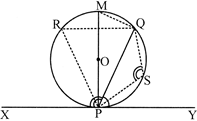
Converse of Alternate Segment Theorem
A line is drawn through the end point of a chord of a circle such that the angle formed between the line and the chord is equal to the angle subtended by the chord in the alternate segment. Then, the line is tangent to the circle at the point.
Common tangent to Two circle in a plane
If the same line is tangent to two circles drawn in the same plane, then the line is called a common tangent to the circles. The distance between the point of contacts is called the length of the common tangent.
In the figure, PQ is a common tangent to the circles with centres, \[{{C}_{1}}\] and \[{{C}_{2}}\]. The length PQ is the length of the common tangent.
(i) 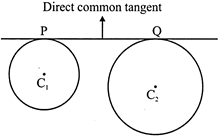 (ii)
(ii) 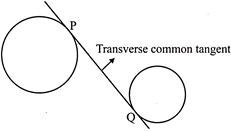
In Figure (i), we observe that both the circles lies on the same side of PQ. In this case, PQ is a direct common tangent whereas in figure (ii), we notice that the two circles lie on either side of PQ. Hence, PQ is a transverse common tangent.

2. The number of common tangents to two circles touching internally is one.
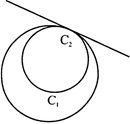
3. The common tangents to two intersecting circles, are TWO direct common tangents, as shown below.
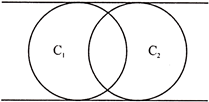
4. The common tangents to two circle touching externally, are TWO direct common tangents and ONE transverse common tangent. (Total = 3)
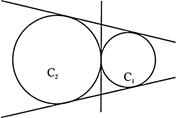
5. The common tangents to non – intersecting circles are TWO direct common tangents and TWO transverse common tangents. (Total =4, see figure below).
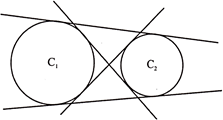
Note on Common Tangents
Case 1: Two circles with centres \[{{C}_{1}}\] and \[{{C}_{2}}\]touch each other internally at \[P.{{C}_{1}}{{C}_{2}}\] P is the line drawn through the centres and RS is the common tangent at P.
\[\therefore \]\[~{{C}_{1}}{{C}_{2}}P\] is \[\bot \] to RS.
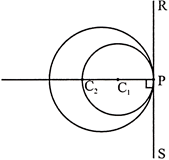
Case 2: Two circles with centres \[{{C}_{1}}\] and \[{{C}_{2}}\] touch each other externally at P. Here, \[{{C}_{1}}{{C}_{2}}\] is perpendicular to XY.
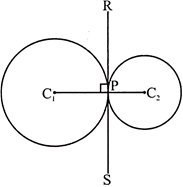
Case 3: The direct common tangents to two circles of equal radii are parallel to each other.
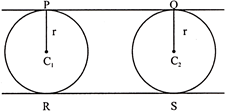
Mathematical Statement:
Let there be two circles of equal radii ‘r’ have centres \[{{C}_{1}}\] and \[{{C}_{2}}\] Also, let PQ and RS be the direct common tangents. Then\[PQ\parallel RS\].
You need to login to perform this action.
You will be redirected in
3 sec
